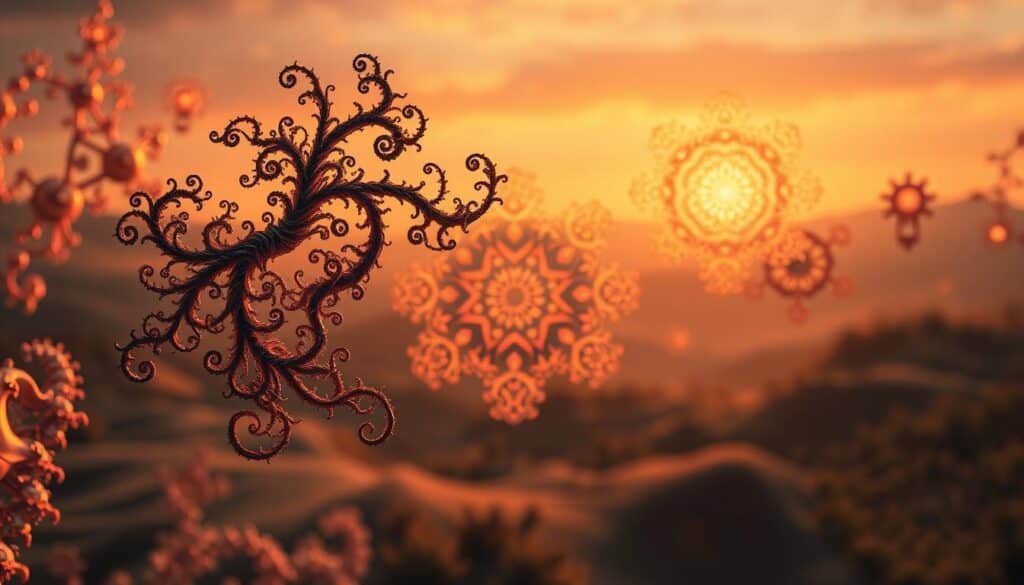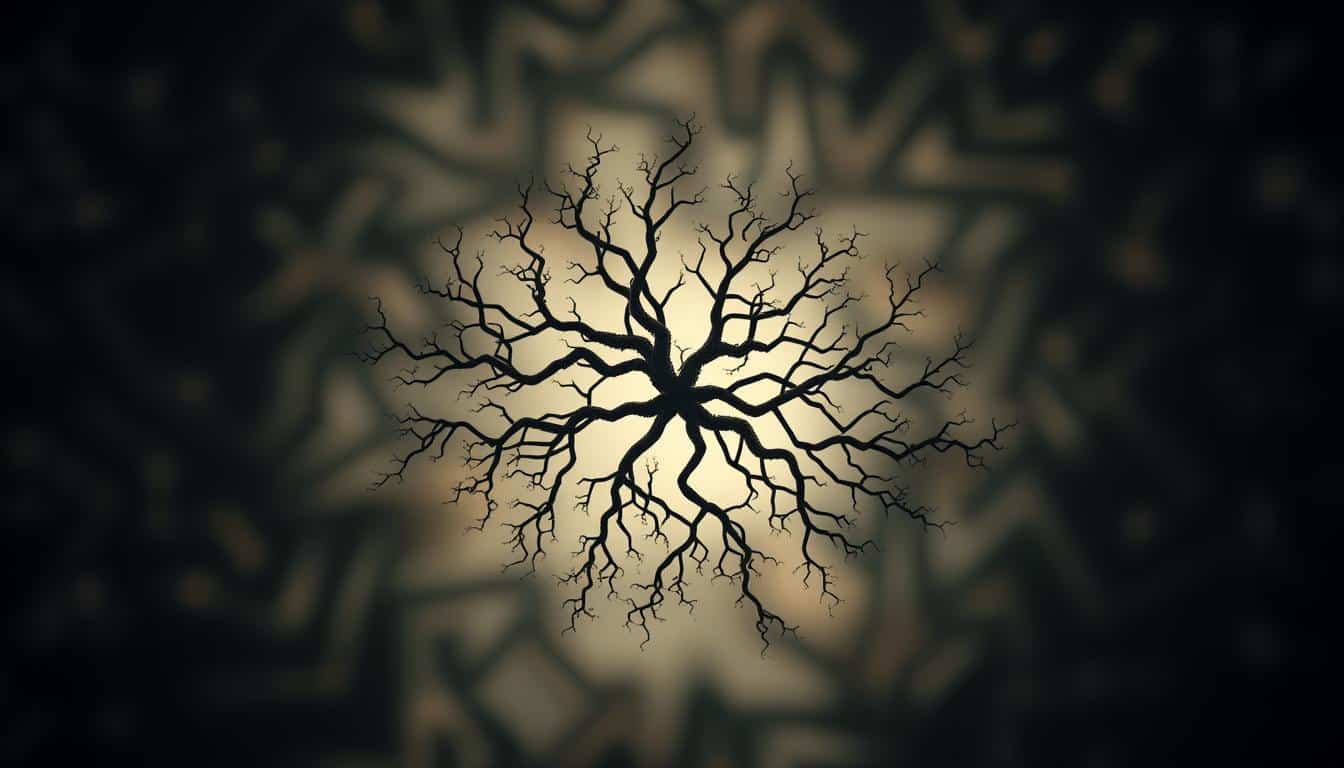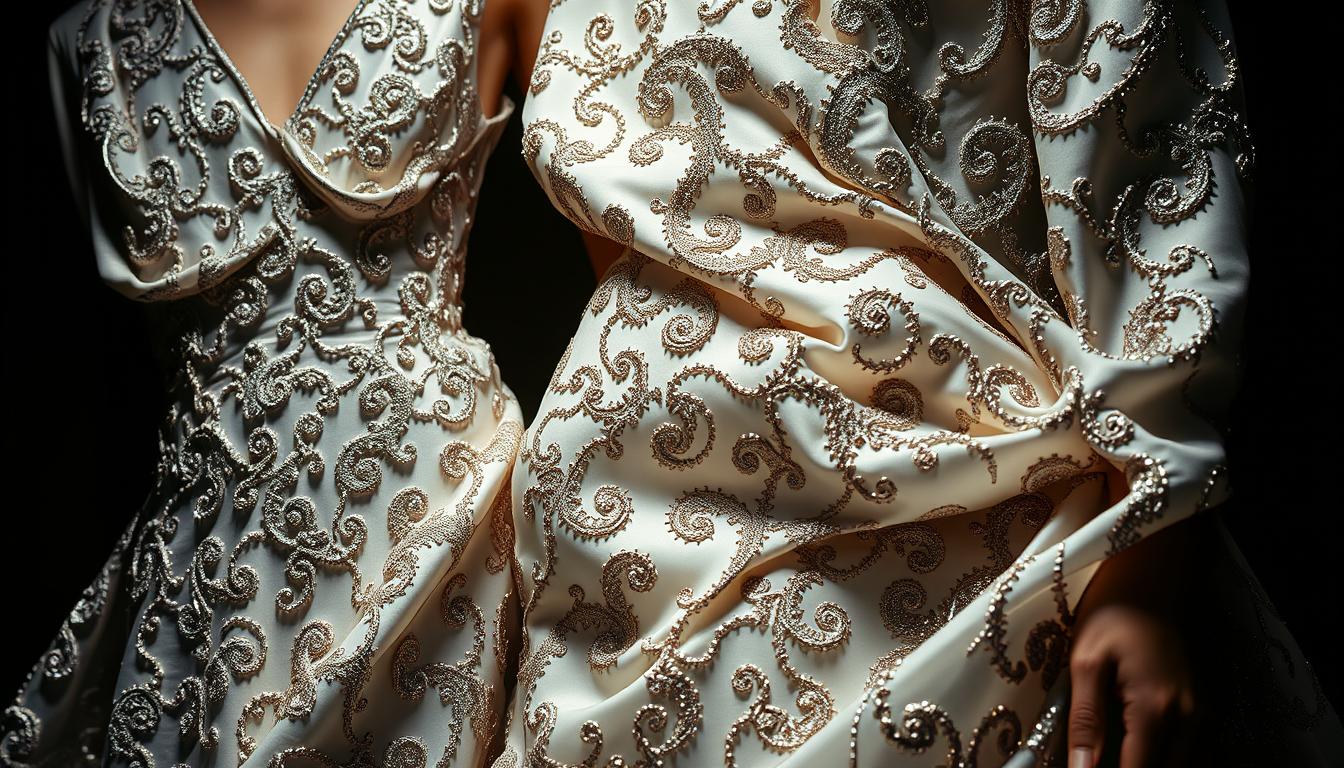Fractals show complex patterns that repeat on different scales. They are very important in stories and culture. Through fractals, we can better understand the structure and themes in stories, art, and myths.
Their use in stories shows the balance between complexity and simplicity. They help us see how stories can have both order and chaos. By looking at fractals in symbols, we learn more about how they make stories richer. This gives us deeper insight into the stories we share and love.
Introduction to Fractals
Fractals are an amazing part of math, known for patterns that repeat on different scales. They make complex shapes that go beyond normal geometry. Benoît Mandelbrot was the first to dive deep into fractals, showing how they help us understand complex systems.
Fractals make us rethink shapes and sizes in math. They let us see both math and nature in new ways, like looking at coastlines or clouds. They blend order and chaos, linking to how we enjoy stories.

By seeing how fractals and stories are connected, we learn more about math in our culture. This guide helps us see how math and stories come together, making theory feel real.
The Mathematical Foundations of Fractals
Fractals are a unique blend of art and mathematics. They show their beauty through the mathematical foundations of fractals. These structures have complex patterns that look similar at different scales. They push the limits of traditional geometry. Besides being beautiful, fractals show deep mathematical ideas. They help us understand the world better.
The core idea behind fractals is recursive patterns. A simple step is repeated over and over to create something complex. These recursive figures help us model nature. They show us shapes and patterns that regular geometry doesn’t. Fractals bring light to complexity theory. They show how things can work on many levels at once.
Benoît Mandelbrot’s work has been crucial in fractals. He showed how fractals are in nature, like coastlines, and in math ideas. His work links recursion, self-similarity, and complexity. It shows how math and the physical world are closely linked.
Studying fractals helps us understand complex systems better. Seeing recursive patterns gives us a clearer view of how chaos works. It uncovers the delicate balance between simple and complex in nature.
Fractals in Nature: Patterns and Structures
Fractals show us the beauty and complexity in the world. They are in the branching trees and snowflakes’ designs. Examples include eroded coastlines and cloud formations with fractal qualities.
Fractal math can model complex structures. The branching of trees and growth of ferns show patterns that repeat. These patterns show how each part reflects the whole, highlighting self-similarity in nature.
Nature’s patterns and human stories are deeply connected. People see their life’s challenges mirrored in these designs. Recognizing nature’s fractal patterns helps us understand balance and harmony, themes found in many cultures.
The Role of Fractals in Storytelling and Symbolism
Fractals in stories are more than patterns. They show complex structures in tales. Themes and motifs repeat at different levels, weaving a deep meaning.
This link between stories and math uncovers new layers of symbolism. It helps us understand texts better.
Understanding Recursion and Self-Similarity
Stories reflect each other, similar to fractals in nature. By revisiting themes or events, stories take us on familiar, evolving journeys. This makes us see connections across different stories and cultures. It highlights shared human experiences.
Fractals as Metaphors in Literature
Fractals in writing create powerful metaphors for life. They describe how life’s complexities repeat and change. Writers use this to share deep emotions and situations. It shows how personal battles are part of a bigger story.
By mixing individual and group stories, writing uses fractals to show our connectedness. It highlights continuity in stories, showing the human condition through a unique lens.
Historical Context of Fractals in Cultural Narratives
Fractals have existed long before modern math did. They are part of stories told through the ages. In terms of patterns and structures, they show the depth of human stories. Ancient societies blended math and philosophy, affecting the tales they shared.
Throughout history, math has left its mark, showing fractals in myths and sacred texts. Civilizations like the Maya and Indians used fractal designs in their artwork. They combined art and math, showing that fractals are more than natural shapes. They express life’s complexities and important beliefs.
Fractals are symbols of order in chaos, highlighting a universal journey for understanding. Ancient Egyptians and Celts used sacred geometry, including fractals, in their traditions. These patterns across cultures show a quest to decode life’s puzzles. They urge us to think deeper about fractals, enriching our shared stories.
Fractals in Art and Aesthetics
Fractals in art mix math accuracy with endless creativity. This blend grabs the attention of both artists and viewers. Through fractal elements, artists can show many emotions in their creations.
This link between art and fractal math shows artists using patterns to mirror life’s complexities.
Visual Appeal of Fractal Patterns
Fractal patterns are unique because they repeat and are similar to each other. They make people want to look closer at art. Artists like Jackson Pollock and Piero Manzoni use fractals to draw viewers in.
These complex designs make an art piece more involving. They invite viewers to stay longer and feel more deeply.
The Impact of Fractals on Emotional Responses
Studies show fractals in art link to good feelings in viewers. Fractals that look like nature can make people feel relaxed and happy. Cognitive science studies suggest fractals lower stress and boost mood.
By using both art and math, fractals start important conversations with viewers. They lead to stronger emotional connections.
Cognitive Science Perspectives on Fractals
Cognitive science fractals offer a unique way to view human understanding of complex stories. This approach shows how recognizing patterns makes it easier to get the gist of tales. Using fractal structures in stories matches our brain’s natural way of making sense of experiences.
Knowing fractal patterns helps people get through complicated stories easier. Stories that use these patterns touch our emotions more and make us understand them better. This makes the stories we hear or read feel closer to us, deepening our connection to them.
This concept is useful across different ways of telling stories. It means writers who know how our brains work can make stories more gripping and meaningful. By understanding how fractals affect our perception, they can tell stories in clearer, more impactful ways. This not only makes stories better but also shows how storytelling and brain science are linked.
Fractals in Folklore and Mythology
Fractals in folklore show deep meanings that spread through cultures. Myths use repeating patterns to mirror life’s complexity. These stories include common figures like heroes and wise elders, acting out universal themes. These themes reappear, much like fractals, in different stories across traditions.
Looking at how these themes show up again and again helps us see their fractal nature. These repeating patterns make stories richer and push us to think deeply about life. They mix personal struggles, society, and the universe, showing how fractals help us understand our world.
Myths with fractals also share deep symbols, showing more than just a story. They weave a complex picture that shows life’s many sides, reflecting our own stories in these ancient tales. Fractals in myths draw us into the story, making us think and sometimes change how we see the world.
Applications of Fractals in Modern Storytelling
Today, the use of fractals in storytelling is changing how stories are told in media. Writers use fractal structures to make complex stories that grab people’s attention in new ways. These fractal properties add layers to stories, making them rich and engaging on many levels.
Filmmakers now use fractals to show life’s complexities, making stories feel real and easy to connect with. Similarly, in literature, fractals help build deep character development. They highlight personal growth and the journey of discovering oneself.
In interactive storytelling, like video games, fractals offer branching paths for players. This approach makes exploring the game world more engaging. It gives players the power to uncover the story through their choices.
Studies show that using fractals in stories makes them more engaging and easier to understand. By using these methods, creators make complex ideas more relatable. This makes the audience’s experience both enjoyable and meaningful.
Conclusion
Studying fractals in stories and symbols shows how they connect chaos and order. This finding points out the role of fractals in making stories and visuals more complex. By looking at the links between math, art, and stories, we discover a world rich with connections from different fields.
Fractals make stories more engaging and create a feeling of connection. They offer new ways for writers and artists to tell stories that don’t follow a straight line. This mix of science and art lets creators take storytelling to new levels.
In short, fractals are more than just math wonders. They play a key part in storytelling. They help us understand and feel stories better, leading to new ways of telling them. This will surely lead to more innovation in stories shared on various platforms.



